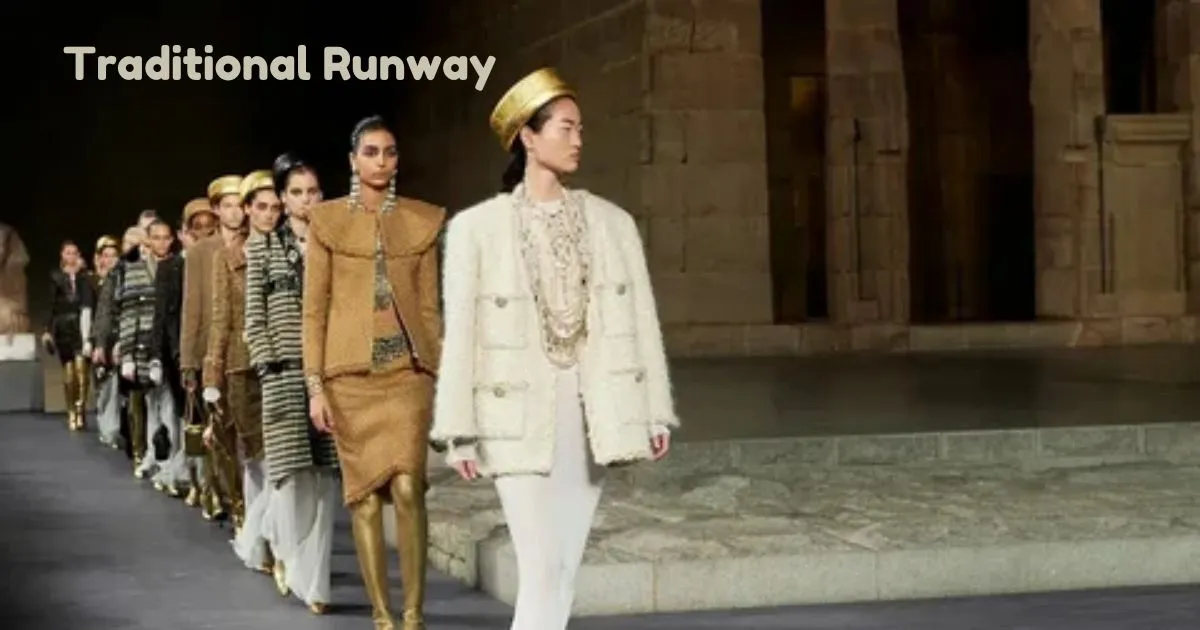A fashion show is a prepared occasion where designers showcase their modern-day collections on a runway, supplying their creations to enterprise specialists and the general public, placing developments, and highlighting new patterns.
Ever questioned how state-of-the-art fashion traits make their grand debut?
Fashion shows serve multiple purposes: they set developments for upcoming seasons, sell designers’ paintings, and create media buzz. Each display is a carefully orchestrated performance that combines fashion with entertainment, reflecting the cutting-edge patterns and improvements inside the enterprise.
The Evolution of Fashion Exhibits: From Runway Beginnings to Modern Spectacles
Historical Source
Early Fashion Exhibitions
Fashion shows hint again at the nineteenth century, where they were initially personal activities held with the aid of couturiers to show off their new designs to chosen consumers.
Charles Frederick Worth

Often credited with creating the primary high fashion style show in Paris, setting the stage for future shows.
Development Through Decades
Nineteen Twenties and Nineteen Thirties
The upward thrust of public fashion in Paris, regularly followed by using stay song and theatrical factors, commenced to form present-day style occasions.
Post-War Era
Fashion shows became greater complex and international, with predominant designers hosting exhibits in more than one town and attracting global interest.
Modern Spectacles
Innovative Formats
Today’s fashion suggestions include technology, multimedia, and interactive elements. Runways are designed with innovative topics and advanced lights to decorate the viewing experience.
Global Reach
Fashion presents now arise in main cities worldwide, which include Paris, Milan, New York, and Tokyo, reflecting the global nature of the fashion enterprise.
Behind the Scenes: How Fashion Exhibits Are Planned and Executed
Pre-Show Preparations
Concept Development
Designers conceptualize their collections, thinking about subject matters, colors, fabrics, and basic aesthetics. This section consists of developing mood boards and initial sketches.
Casting and Rehearsals
Models are decided on and fitted for the show. Rehearsals are carried out to make sure clean transitions and unique timing for each segment of the display.
Production Logistics
Set Design and Technical Setup

The runway is designed and constructed, often incorporating difficult sets and visual results. Technical groups manipulate lights, sound, and stage mechanics.
Coordination and Timing
The entire occasion is meticulously deliberate, with unique timing for each segment, which includes version entrances, music cues, and transitions.
Day of the Show
Final Preparations
Last-minute adjustments are made, including the very last fittings for models and assessments on all technical components.
Show Execution
The event unfolds with models showcasing the designs, accompanied by utilizing audience reactions and media insurance. The show is regularly streamed online for broader access.
The Impact of Fashion Exhibits on Trends and Industry Dynamics
Trendsetting Influence
Seasonal Trends
Fashion suggestions are pivotal in putting developments for upcoming seasons. Designers use those platforms to introduce new styles, colors, and fabrics that impact destiny collections.
Innovation Showcase
Reveals frequently feature groundbreaking designs and ideas that push the limits of style, inspiring different designers and types.
Industry Dynamics
Market Influence
The fulfillment of a fashion show can impact income, emblem reputation, and market positioning. Positive reception can result in elevated media insurance and purchaser interest.
Buyer Engagement
Fashion buyers attend suggests to scout for new traits and make shopping choices for retail shops, affecting the supply of certain designs within the marketplace.
Media and Public Perception
Media Coverage
Fashion reveals generate massive media buzz, with coverage ranging from fashion magazines to social media systems. This publicity enables shaping public belief and logo photographs.
Celebrity Endorsement
The presence of celebrities and influencers in fashion suggests the occasion’s charm and may significantly impact the recognition of the showcased designs.
Notable Fashion Presents That Shaped the Industry: Iconic Moments in Fashion History
Iconic Fashion Reveals
Chanel’s 2004 Paris Show
Known for its modern set design and dramatic presentation, this show redefined style show expectancies.
Victoria’s Covert Style Show
Renowned for its opulent concerns and immoderate profile styles, this show has arisen as a ethnic wonder, merging elegance with delight.
Historical Milestones
Dior’s New Look (1947)
Christian Dior’s debut series, which featured the now-iconic “New Look,” was a sport-changer in submit-conflict style, emphasizing femininity and luxury.
The First Haute Couture Week (1945)
Marked the authentic start of Paris Fashion Week, putting a precedent for the business enterprise and presentation of favor suggests.
Cultural Impact
Influence on Pop Culture
Iconic indications have influenced not only the simplest fashion but also popular culture, impacting how style is perceived and consumed globally.
Legacy and Evolution
These suggestions have left an enduring legacy at the fashion enterprise, continually inspiring new generations of designers and shaping the evolution of style presentation.
Fashion Show Formats: Traditional Runway to Digital Presentations
Traditional Runway Reveals

Classic Runway Format
Models walk down a runway linearly, showcasing designs in a controlled and choreographed way. This layout highlights the clothes’ fit and motion.
Theatrical Elements
Many conventional exhibits incorporate problematic sets, songs, and lights to create an immersive enjoyment for the audience.
Digital Presentations
Virtual Runways
With improvements in the era, style displays are increasingly held online. Designers create digital runways and virtual displays to reach a worldwide target market.
Interactive Features
Digital formats frequently include interactive elements which include stay streams, 360-degree perspectives, and online purchasing hyperlinks, improving the viewer’s engagement.
Hybrid Formats
Blended Experiences
Some fashion suggests integrating traditional and virtual elements, bearing in mind both in-person and virtual attendance. This method maximizes reach and accessibility.
Innovative Techniques
Hybrid reveals may additionally use augmented fact (AR) and digital truth (VR) to offer particular experiences, together with digital fittings or immersive show environments.
The Role of Models, Designers, and Creatives in a Fashion Show
Models
Showcasing Designs
Models are the focus of fashion, presenting the dressmaker’s creations and highlighting the garment’s shape and motion.
Collaboration with Designers
Models paintings carefully with designers to ensure that the garb is supplied as meant, frequently presents process fittings and rehearsals.
Designers
Creative Vision
Designers conceptualize and create the collections offered at fashion presents. Their function includes deciding on fabric, designing garments, and orchestrating the overall presentation.
Leadership and Coordination
Designers oversee the whole show, coordinating with numerous teams to ensure that their imagination and prescience are appropriately realized.
Creatives
Set Designers
Create the visible surroundings for the display, together with the stage layout and props. Their work complements the thematic factors of the presentation.
Hair and Makeup Artists
Responsible for styling models to supplement the clothes and average topics. Their work performs a critical function in the very last presentation.
How Fashion Exhibits Influence Media and Public Perception
Media Coverage
Fashion Journalism

Fashion suggests acquiring sizable insurance from style reporters, bloggers, and influencers, who analyze and critique the collections, shaping public opinion.
Social Media Impact
The upward push of social media has amplified the attainment of style. Live updates, in the back-of-the-scenes content, and influencer posts contribute to the event’s visibility.
Public Perception
Trend Adoption
The public notion of style indicates impacts on customer development. Designs featured in reveals frequently come to be famous amongst consumers, riding sales, and style developments.
Brand Image
Successful displays decorate the emblem’s image and popularity, while poorly obtained suggestions can affect an emblem’s status in the enterprise.
Cultural Influence
Fashion as Art
Fashion often elevates style to an artwork form, influencing cultural and aesthetic values. The inventive presentation can encourage other creative fields and contribute to broader cultural moves.
Consumer Behavior
The exhilaration and appeal generated by utilizing fashion can power consumer conduct, with audiences seeking to emulate the patterns and traits showcased.
FAQs
What is the reason for a style display?
To show off new designs, set trends, and promote brands.
Who attends fashion shows?
Industry professionals, media, celebrities, influencers, and now and again the public.
How are fashions selected for style suggestions?
Through casting calls, agencies, and fittings.
What are the key elements of a hit-style display?
Planning, innovative routes, manufacturing first-rate, and coordination.
How do fashion shows impact consumer behavior?
By setting tendencies, shaping brand notions, and producing buzz.
Conclusion
Fashion shows suggest pivotal activities in the style industry, blending creativity, meticulous plans, and excessive manufacturing values. They unveil new collections, set upcoming developments, and influence client alternatives. These occasions now not only have fun design innovation but also beautify emblem visibility and enterprise dynamics.
You can also read this Post:
What is Cyberpunk Fashion

